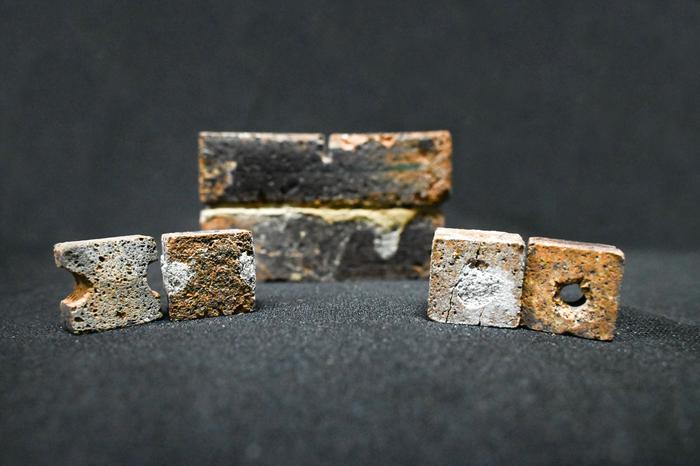Researchers at the Indian Institute of Science (IISc) have embarked on an ambitious project aimed at creating a bacteria-based method for repairing bricks that could potentially be used in constructing habitats on the moon. These bricks, specifically designed for the extreme and unpredictable environmental conditions of the lunar surface, showcase the cutting-edge intersection of biotechnology and space exploration. This innovative technique aims not only to save costs by utilizing local lunar soil but also to enhance the resilience and longevity of building materials essential for future lunar missions.
As humanity prepares for permanent habitation on the moon through initiatives like NASA’s Artemis program, the traditional concepts of lunar exploration have evolved significantly. Rather than merely sending astronauts on short missions, the vision now encompasses the establishment of enduring structures using resources found directly on the moon. This endeavor signifies a monumental shift towards sustaining life beyond Earth through self-sufficient means, which includes leveraging the moon’s plentiful regolith—an amalgamation of broken rocks and minerals.
The pioneering method developed by the IISc research team utilizes a unique bacterium, Sporosarcina pasteurii, known for its ability to precipitate calcium carbonate. The process involves mixing the lunar soil simulant with urea and calcium, allowing the bacterium to produce calcium carbonate crystals that effectively bond the soil particles, thereby creating a resilient brick-like formation. This eco-friendly approach presents a compelling alternative to traditional cement, which requires substantial energy and resources for production.
In their earlier studies, the team delved into the conventional method of sintering, where a compacted mixture of soil and a polymer known as polyvinyl alcohol is heated to considerable temperatures. This process results in bricks with exceptional strength, capable of supporting habitation and construction needs. Aloke Kumar, an Associate Professor at the IISc’s Mechanical Engineering department, highlighted that sintered bricks demonstrate superior strength, exceeding what is necessary for typical housing structures.
However, the reality of the lunar environment poses substantial challenges, with extreme temperature fluctuations and relentless solar wind exposure that can lead to cracks and structural weaknesses in conventional sintered bricks. These temperature changes, which can range dramatically from 121°C during the day to -133°C at night, raise concerns about the durability of materials used for lunar structures and necessitate innovative solutions to ensure their longevity.
To address this critical issue, the IISc team turned back to their original microbiological solution. In their latest research, they created various artificial defects in the sintered bricks and introduced a specially formulated slurry containing S. pasteurii, guar gum, and lunar soil simulant. Over several days, the slurry penetrated the imperfections in the bricks, allowing the bacterium to generate calcium carbonate, which subsequently filled the cracks. In addition, the bacterium produced biopolymers that acted as adhesives, reinforcing the overall structure and significantly restoring lost strength.
Initial skepticism surrounded whether the bacteria would successfully bond with the sintered brick material. However, the results revealed that not only could the bacteria stabilize the slurry, but they also adhered remarkably well to the brick structure itself. This innovative reinforcement process enables these bricks to endure higher temperature ranges, from 100°C to 175°C, thus enhancing their suitability for lunar construction.
An essential consideration in this research includes understanding how these bacteria behave under extraterrestrial conditions, particularly in terms of their metabolic processes and their ability to produce calcium carbonate in microgravity. The complexities of interstellar biology can pose unpredictable consequences, and researchers are keen to investigate whether such microorganisms will maintain their functionality in the significantly different conditions of the moon.
The IISc team is presently drafting proposals to include a sample of S. pasteurii in the Gaganyaan mission, India’s ambitious initiative to send humans into space. This planned experiment could potentially mark a groundbreaking first for testing biological systems under microgravity conditions, contributing to our understanding of how life can adapt and thrive beyond our planet.
This research reflects an important step forward in the intersection of biological sciences and space engineering. By harnessing the power of microorganisms to regenerate building materials, the potential to create livable environments on the moon becomes much more plausible. As scientists continue to explore this frontier, the implications extend beyond mere construction; they pave the way for futuristic sustainable practices that could revolutionize how humanity utilizes extraterrestrial resources.
The innovative use of bacteria to repair buildings could not only benefit lunar expeditions but also inspire eco-friendly construction practices on Earth. This dynamic intersection of biology and engineering stands to reshape how we approach some of the most pressing challenges related to sustainability, durability, and resource utilization in a rapidly evolving world.
As research progresses, the collaborative efforts of scientists and engineers at IISc illustrate an inspiring model of interdisciplinary approach, paving the way for groundbreaking advancements in the quest for extraterrestrial habitation. The findings promise not only to impact lunar missions but also to influence how we perceive and utilize biological systems in the broader context of future human exploration beyond Earth.
Subject of Research: Bacteria-based technique for repairing bricks for lunar habitats
Article Title: Bacterial bio-cementation can repair space bricks
News Publication Date: 27-Mar-2025
Web References: Frontiers in Space Technologies
References: Frontiers in Space Technologies DOI
Image Credits: Credit: Amogh Jadhav
Keywords
Lunar construction, bacteria, Sporosarcina pasteurii, biodegradable cement, extraterrestrial habitation, lunar soil simulant, sustainability, space exploration.




